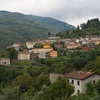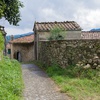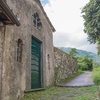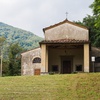Castle of Pescaglia
Pescaglia is a large town that stands on the top of a plateau on the southern slopes of Monte Cuculiera, at the confluence of the Solco di Canovaglia with the Pescaglia river. From this tactic position it was possible to guard the paths which led from the Pedogna valley to the Versilia through the Foce di Bucino, the Garfagnana and the Valfreddana.
Once on top of the hill overlooking the town, the view is immediately captured by the imposing Renaissance fortress, provided with struts and sharp edges, enclosing an area of about 3,000 square metres, then descending to enclose the entire town. What remained of the medieval fortress, a building situated at the highest point of the rise, has been incorporated in this large architectural complex and you can still make out the ruins. The fortress preserves long stretches of walls, which allow us to identify the original perimeter. The circuit of walls was completed by a series of rooms, some inserted within the ancient mediaeval walls, others built on occasion, such as housing for the captain of the fort.
The church of SS. Pietro e Paolo was completely rebuilt in the seventeenth century. Inside are housed a Madonna and Child with Saints by Marracci, a canvas of San Rocco by Gaspare Mannucci and a picture of the Madonna with Child hailing from the Oratory of the Solca in Monte del Paese.
From Pescaglia you can also reach the high valley of the Turrite and the Alto Matanna, from where you begin excursions on the Apuan Alps.
Historical notes
Until 1242, the town of Pescaglia depended on the coterie of the Suffredinghi; later the town was annexed to the Vicariate of Coreglia under which it met its fate. The castle was destroyed by the city of Lucca in the thirteenth century, and was definitely rebuilt before 1376, when the town is listed among the "castrums" present in the Golden Bull signed by Emperor Carlo IV. At the end of the sixteenth century, the ancient fortress of Suffredinghi was profoundly modified and expanded by architect Vincenzo Civitali.












